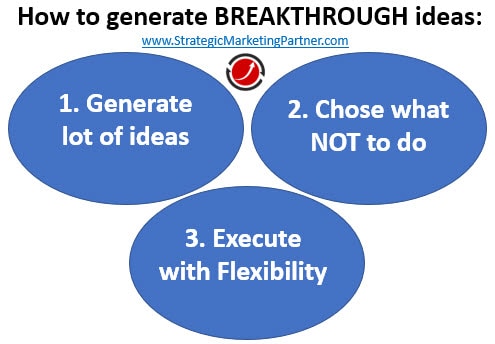Monopoly vs Monopsony: The difference (+examples)
If you are looking for the difference between a monopoly and a monopsony, look no further! In this article we […]
Read More »Become a successful marketing consultant: Learn more

Dictionary.com defines a breakthrough as a
Sudden, dramatic, and important discovery or development of achieving success in a particular activity.
This might be usually found in the discovery of a new medicine, an anti-aging drug, or a new music artist.
But what about a breakthrough in regular business?
A breakthrough in business is found by continuing to ask the Who-What-How questions in your business. “Who” are your ideal customers, “What” do you want to provide to them, and “How” will you effectively do this. This activity forces you to focus forward and regularly make incremental progress potentially creating a massive breakthrough.
After all, it's probably most business owners' dream to champion an innovative product or develop a new service that brings a flood of customers and sales revenue into the business.
So what exactly is a breakthrough in business and is there a strategy to develop breakthroughs?

Before we dig into some structure to develop breakthrough ideas and put the odds of breakthrough success in your favor, heres a few examples to consider:
What do these breakthrough concepts have in common?
They all took on massive industries with new concepts that did not exist until they developed them, largely by asking the right questions and continually focusing forward.
Onward.
When you create a strategy, it is very important to CHOOSE a strategy.
A good friend is a golf psychologist to the best golf athletes in the world, Dr Joseph Parent. He tells his world class golfers, “Make a decision.” If you plan on going for the green, go for the green. If you plan on playing it safe back to the fairway, aim for the fairway. Don’t be indecisive as you will end up somewhere in the middle, and not where you ultimately want.
And this is the same as your breakthrough strategy.
This means making clear choices. And it relies up these three very clear components:
1. Decide upon who you want as customers. This is called “The who” and is answered by asking, “Who should I target as customers?”
2. Decide upon what you want to sell. What product and or what service. This is called the “The what” and is answered by asking, “What products or services should I offer them?”
3. Decide upon how you will deliver this product or service to this customer. This is called the “The how” and is answered by asking, “How should I do this in an efficient way?”
For example, if Elon did not ask himself who he wanted as a customer, “high end drivers who value an environmentally friendly experience,” he would not have developed what one day became the Ultimate Car of the Year.
A company cannot be everything to everybody. Of course this sounds so simple, but it is a common idea that plagues most business owners who think their product or service can help everyone in the world. Even if it does have the potential to help everyone, which it may, it is not economically realistic to communicate your message to everyone. You must focus.
Your company must choose what to do and what NOT to do.

Here's a plan to generate breakthrough ideas.
1. Generate as many ideas as possible. This is called “ideation, '' and it's literally the process of documenting as many ideas as possible. In this phase there is no such thing as a good or a bad idea. In this phase you simply want to explore “who to target, what to offer, how to do it?”
Question everything and make this the norm for the culture of your organization.
2. Evaluate and choose what to do and what NOT to do. In this phase you will carve down your ideas and start to isolate some ideas that make the most sense. If you have a team to work with, let the wisdom of the team decide which ideas are best. If you are a one-person show, identify what you believe are the best ideas.
3. Implement while remaining flexible to changes in the environment. It's this phase where the magic happens. This is where you have one real objective: find message-market fit. If you find market fit, now test the same message to more people in your target market. If you get similar results, but bigger in the same scale, you may have the seed of a breakthrough winner. For many of us, finding FIT may require even up to hundreds of tests. You might find fit in your first attempt. Technology such as Facebook and Google Ads has made this process of testing much much easier on marketers.
Go here for more information on finding fit.
It is important to note: No strategy is unique forever.
There is always someone else trying to steal your customers by developing a better product or service at a better price.
As soon as you get comfortable, the decline has started.
You are either growing or declining. There is no in-between.
This is why the best companies have a habit of:
Playing to win, and NOT playing 'not to lose'.
The same is true in sports. The greatest teams are those that play to win. And business is no different.
The act of continually searching for a breakthrough strategy is virtually a guaranteed method of playing to win, and not playing not to lose.
At least two important things are happening when you are focused on a breakthrough.
Most company's strive for incremental growth. They make this habit.
But when you are regularly searching for a breakthrough strategy, you are, by default, raising the level of performance of everyone on your team.
You will not only make marginal improvements like others in your industry, but you will also be regularly locating new markets, and providing more services and better products to customers you haven't even thought of yet.
And you will regularly find:
And soon, you’ll be the one creating the breakthrough.
For your convenience, here is an action checklist you can use to create an environment within your business to continually search for and uncover your own breakthrough.
References: